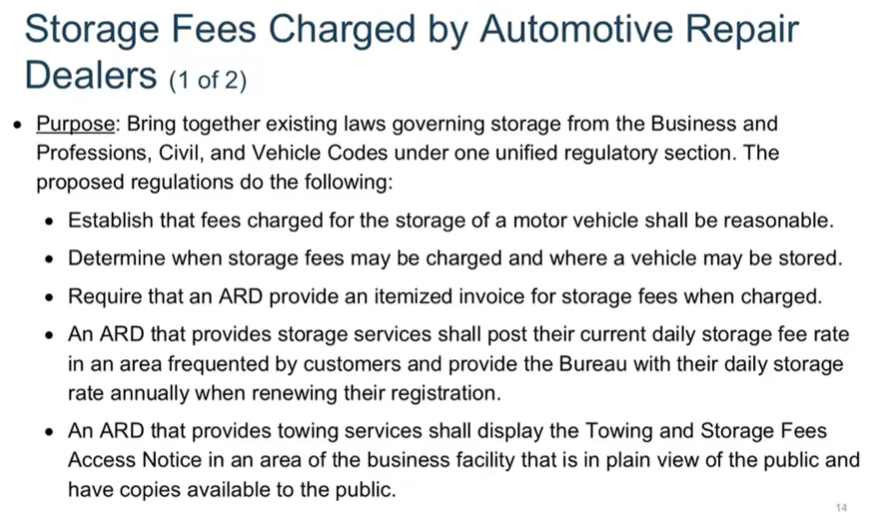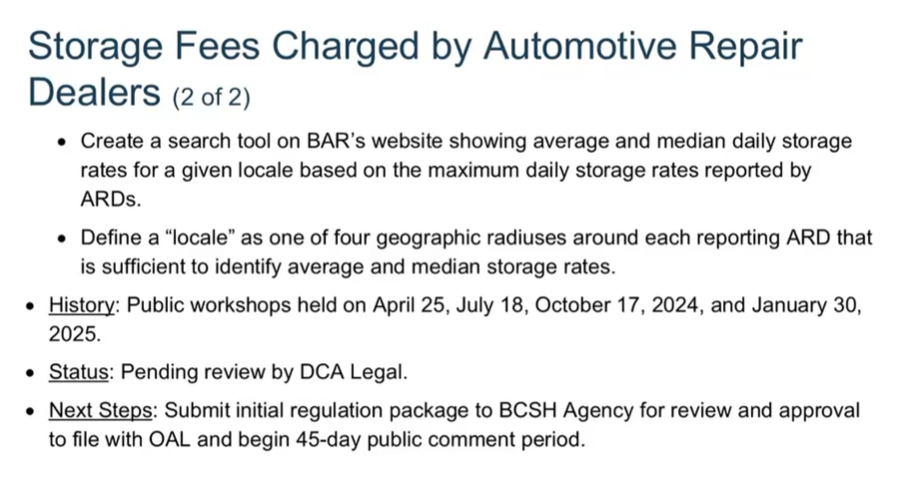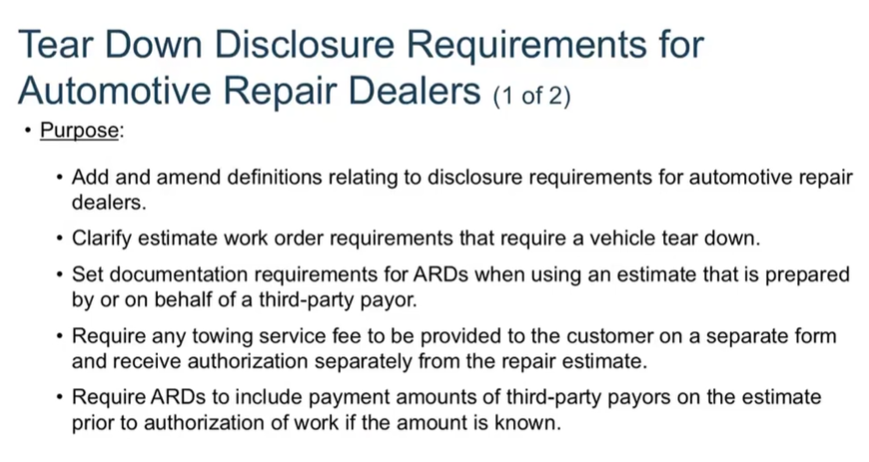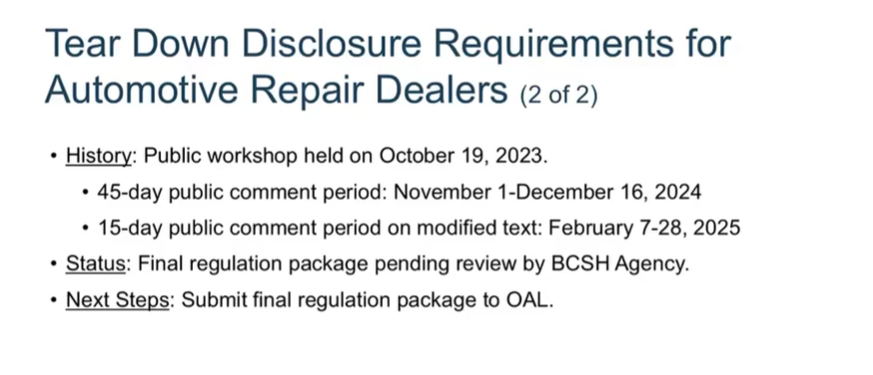
California BAR conducts storage fee complaint case study
By onBusiness Practices | Collision Repair
The California Bureau of Automotive Repair’s Field Operations and Enforcement Division recently conducted a complaint case study to illustrate teardown and storage fee complaints BAR receives from collision repair shops and auto insurance companies.
Proposed regulations from BAR on teardown disclosures and storage, and towing fees in the state are moving through the approval process. There will be additional opportunities for public comment on the proposals in the coming months. Repairers have said the storage regulations wouldn’t hold third-party payers accountable for delayed repair authorizations from insurance companies that lead to storage fees taken out of customer payments.
During an April 24 BAR Advisory Group meeting, BAR Field Operations and Enforcement Division Deputy Chief Bill Thomas shared the results of his division’s complaint case study.
In the example Thomas shared, it took 10 days from the time the shop informed the insurance company that the vehicle was a total loss to request that the owner release it.
“The ARD knew and acknowledged knowing on the third day the vehicle was at their facility that it wasn’t going to be repaired and they should have started charging storage from that day, period,” Thomas said. “Then, when the insurance company asked for a total loss settlement value, it should be storage from that day but instead they made the decision to put Jan. 13 repair charges. Now they’ve turned it into a repair transaction.”
According to BAR, this was the shop’s timeline:
-
- Dec. 27 – vehicle presented for repair at ARD selected by registered vehicle owner
- Dec. 30 – ARD informs insurer vehicle is a total loss
- Dec. 31 – ARD advises insurance adjuster (at facility to inspect different vehicle) vehicle is a total loss
- Jan. 2– adjuster confirms assignment to claim via email
- Jan. 6 – adjuster confirms total loss determination via email
- Jan. 10 – insurer requests registered owner release vehicle
- Jan. 13 – registered owner signs “repair order” at ARD
- Jan. 18 – insurer disputes total loss fees as represented on repair order
And this was the insurance company’s:
-
- Dec. 26– date of loss
- Dec. 27 – loss reported and DRP facility identified
- Jan. 2 – insurer advised of vehicle location
- Jan. 2 – adjuster assigned to inspect vehicle by Jan. 9
- Jan. 6 – vehicle inspected and classified as potential total loss
- Jan. 9 – total loss handling, last date of storage set at January 13, and charges requested from the ARD
- Jan. 14 – second request for charges to ARD
“When did the repair transaction start? When was it authorized? A repair order wasn’t signed by the consumer until Jan. 13, so in the bureau’s eyes, they have no authorization to do repairs, and that vehicle is just sitting there from the 27th to the 13th,” Thomas said. They should have kept it a storage transaction. We see this frequently in our referrals.
“The bureau takes no sides in these and just tries to lay out the facts and apply the laws and regulations that we have jurisdiction over. Given the area where this transaction took place, at $100 a day per storage as identified by the insurance company seems extremely low and is not comparable to what other facilities [charge]. The bureau recognizes that, and we have told insurers in the past that have made referrals to us and have challenged the dollars per day being charged.”
In addition, BAR concluded in this particular case that the shop should’ve been mindful of entering into a repair transaction rather than keeping it as storage-only, and that improper charges “equate to consumer harm and potential enforcement action.”
“We’ve tried to create a mechanism in the regulations to create market storage rates and let ARDs [automotive repair dealers] charge those but sometimes, and we all too often see, this circumstance where the ARD recognizes it’s not a repair transaction — it’s a storage-only transaction,” Thomas said. “Why not inform the consumer of that when that vehicle is there on a tow truck? Say, ‘Look, we don’t think we’re going to be able to repair this vehicle. If you leave it here with us, we’re going to be starting to charge storage beginning today at X dollars per day.'”
At what point in the repair process to begin charging storage rates is a concern collision repair shops have previously voiced. The proposed storage regulations would allow a minimum of three days for authorization after teardown before shops could begin charging for storage. Some have argued that would cause loss of revenue, not only from charging storage, but from the vehicles taking up space.
The regulation would also force shops to use public storage or towing rates if no repair is completed on a vehicle brought to the shop.
According to slides shown at the Advisory Group meeting, the regulations:
The passage of AB1263 last year gave BAR the authority to address storage fees. It also allows BAR to codify its guidance and unify existing laws on the subject.
Regarding proposed teardown disclosure regulations, the following history and update were shown at the meeting:
Images
Featured image credit: surachaikunprayot/iStock




